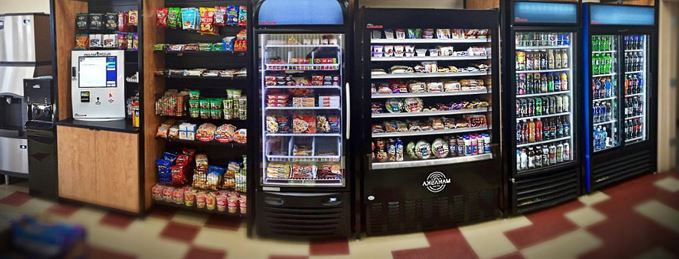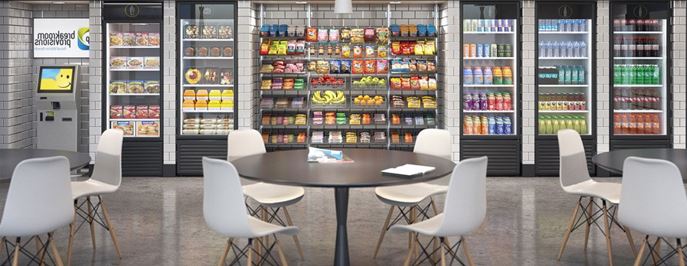
Micro markets reduce the traffic of a corporate cafeteria while providing quick food options for employees. For many businesses, micro markets area simple solution for providing healthy snack or meal options to employees at a reduced cost savings to the employer. Micro markets also allow employees to remain on campus during lunch hours rather than having to leave the workspace to healthy meals. Corporations considering employing micro markets within an office should consider these key points.
Grab and Go
People want quick and easy dining options. The workday offers more snacking and less proper meals, making micro markets ideal. As an all-hours service, everyone has the flexibility to snack when they need it with everything already been made for them.
Less Upfront Costs
Cafeterias call for grills, washing stations, food temperature logs, walk-in coolers and so on. A micro market just needs some coolers, shelves a kiosk and an internet connection; anything further can be handled with the location and purchased to even further improve the desired employee experience for the area.
You Can Buy in Bulk
Micro markets are all about prepackaged products, increasing the volume of items ordered and lower the individual cost of those items through bulk discounts. A good pricing manager can optimize special offers and rebates, making micro market operations able to offer finer quality goods to further drive up sales.
Cost Balance Exists
While fresh food is offered by both types of establishment, cafeterias greatly rely upon food. Food means waste and narrower margins. Micro market operators can provide a blend of variety in food options and shelf-stable goods. A micro market can even include non-food items like small electronics or phone chargers.
They Have a Wider Range of Locales
A cafeteria needs hundreds of employees to handle every aspect of their operation; a micro market needs only between one and two hundred employees. The significantly lower employee headcount means that you have more flexibility regarding checkout options. These options can range from freestanding kiosks to table-based checkouts combined with a shelf/cooler combo. Micro markets can also meet the needs of a wide range of business types from manufacturing plants to office complexes.
You Do Not Need Extra Staff

A cafeteria needs cooks and cashiers, positions that require time and money to hire, train and manage. All a micro market needs is a route driver and support; roles already taken into account with payroll.
A micro market has no need for extra staff to keep it operational and can function for more hours in the day, meaning more employees will be able to make use of the benefits a micro market provides. The reduction is staff is a cost savings but micro markets also allow for less waste than a cafeteria setting.
You Can Do Supported Marketing
Consumers love deals, especially when it concerns their favorite foods. Between new features from suppliers and promotions, specialty pricing and loyalty programs are a breeze to set up. Many micro markets have set up programs that operators can toggle with a single code. Others have special relationships with their suppliers Regardless, micro markets make it easy to market and engage with customers through apps and interactive touchpads.
There Are No Lines
Everything is pre-made and prepackaged, killing the idea of lines of people waiting to order their food or have it cooked. Customers just look over their options and buy what they want. Mobile checkout apps are also a common queue-killer with kiosks. These qualities encourage repeat customers; people like the idea that they can get their one or two little items without having to deal with a rush.
They Need less Space
A cafe or a cafeteria not only needs places for people buy their food and eat it but also space for food to be prepared and stored. Micro markets only need a place to display products and conduct sales. Details like layout, number of coolers, where the kiosks will go, how things will be shelved and even how equipment is powered is quite mutable. Micro markets can adapt and scale to whatever venue wants one.
They Are Employee-Paid
Offering sustenance to employees is a valuable way to acquire and keep good workers but the return-on-investment for food budgets is nebulous. The decision maker for food service might retire or corporate culture can tweak all sorts of food service. Because the capital outlay by the location of a micro market is none, it is less vulnerable to budget and executive issues.
Interesting related article: “What is Return on Investment?“

